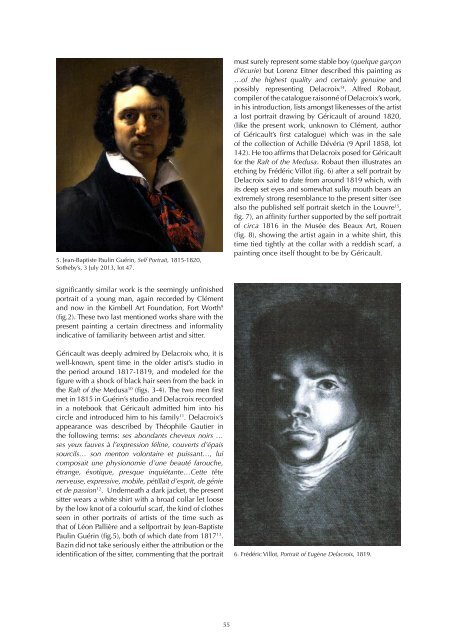Create successful ePaper yourself
Turn your PDF publications into a flip-book with our unique Google optimized e-Paper software.
5. <strong>Jean</strong>-Baptiste Paulin Guérin, Self Portrait, 1815-1820,<br />
Sotheby’s, 3 July 2013, lot 47.<br />
must surely represent some stable boy (quelque garçon<br />
d’écurie) but Lorenz Eitner described this painting as<br />
…of the highest quality and certainly genuine and<br />
possibly representing Delacroix 14 . Alfred Robaut,<br />
compiler of the catalogue raisonné of Delacroix’s work,<br />
in his introduction, lists amongst likenesses of the artist<br />
a lost portrait drawing by Géricault of around 1820,<br />
(like the present work, unknown to Clément, author<br />
of Géricault’s first catalogue) which was in the sale<br />
of the collection of Achille Dévéria (9 April 1858, lot<br />
142). He too affirms that Delacroix posed for Géricault<br />
for the Raft of the Medusa. Robaut then illustrates an<br />
etching by Frédéric Villot (fig. 6) after a self portrait by<br />
Delacroix said to date from around 1819 which, with<br />
its deep set eyes and somewhat sulky mouth bears an<br />
extremely strong resemblance to the present sitter (see<br />
also the published self portrait sketch in the Louvre 15 ,<br />
fig. 7), an affinity further supported by the self portrait<br />
of circa 1816 in the Musée des Beaux Art, Rouen<br />
(fig. 8), showing the artist again in a white shirt, this<br />
time tied tightly at the collar with a reddish scarf, a<br />
painting once itself thought to be by Géricault.<br />
significantly similar work is the seemingly unfinished<br />
portrait of a young man, again recorded by Clément<br />
and now in the Kimbell Art Foundation, Fort Worth 9<br />
(fig.2). These two last mentioned works share with the<br />
present painting a certain directness and informality<br />
indicative of familiarity between artist and sitter.<br />
Géricault was deeply admired by Delacroix who, it is<br />
well-known, spent time in the older artist’s studio in<br />
the period around 1817-1819, and modeled for the<br />
figure with a shock of black hair seen from the back in<br />
the Raft of the Medusa 10 (figs. 3-4). The two men first<br />
met in 1815 in Guérin’s studio and Delacroix recorded<br />
in a notebook that Géricault admitted him into his<br />
circle and introduced him to his family 11 . Delacroix’s<br />
appearance was described by Théophile Gautier in<br />
the following terms: ses abondants cheveux noirs …<br />
ses yeux fauves à l’expression féline, couverts d’épais<br />
sourcils… son menton volontaire et puissant…, lui<br />
composait une physionomie d’une beauté farouche,<br />
étrange, éxotique, presque inquiétante…Cette tête<br />
nerveuse, expressive, mobile, pétillait d’esprit, de génie<br />
et de passion 12 . Underneath a dark jacket, the present<br />
sitter wears a white shirt with a broad collar let loose<br />
by the low knot of a colourful scarf, the kind of clothes<br />
seen in other portraits of artists of the time such as<br />
that of Léon Pallière and a selfportrait by <strong>Jean</strong>-Baptiste<br />
Paulin Guérin (fig.5), both of which date from 1817 13 .<br />
Bazin did not take seriously either the attribution or the<br />
identification of the sitter, commenting that the portrait<br />
6. Frédéric Villot, Portrait of Eugène Delacroix, 1819.<br />
55
















